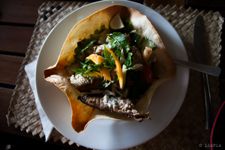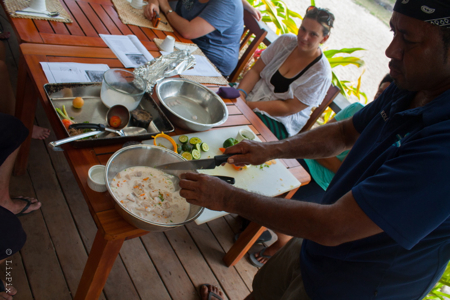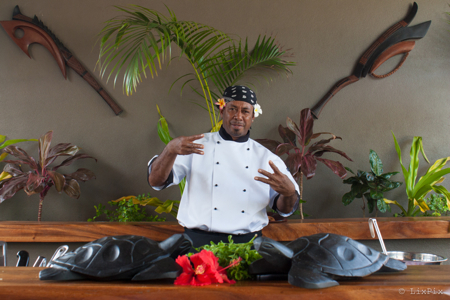02 Mar Seafood recipes, food is culture
Travelling around and have a specific diet can be limiting for experiencing the diversity of flavours from certain cultures. However, as a pescetarian, I discovered three recipes that I would love to share with you. In Fiji I’ve stayed in the wonderful resort The Blue Lagoon, and the kitchen team is really dedicated to deliver some traditional recipes as well as some fusion cuisine plate. The resort includes three meals per day with a great variety and very fresh ingredients. No only all bread was made at the resort, once each week they have events for the clients of the hotel. If we want to know how to make the bread, or to watch how they do their barbecue a la maori style. One of its cultural events, is a cooking show by one of the chefs. And here is the most delicious things I’ve ever tasted there: The Fijian kokoda This is a raw fish dish, perfect as salad or a starter for a fresh summer day. Great dry white wines can accompany it. This recipe serves 2-3 people.
Ingredients:
– 100g of fresh fish, they used one called Wallu and you can replace for Cod
– Lemon Wedges
– Salt and pepper
– Lemon Juice – 2 glasses
– White vinegar (optional)
– Coconut cream – 1 can
– Capsicum 10g
– Onion 10g
– Tomato 10g
– Cucumber 10g
– Carrot 10g
– Pineapple 10g
– Large fresh chilli
How to prepare:
1- Dice the fish and marinate it in lemon juice and salt (10g) for 6-8 hours. As an option you can use vinegar instead of lemon juice. in this case marinated it for 2 hours only.
2- After marinating, strain the liquid and rinse it in fresh water.
3- Take the excess of the salt
4- Dice all vegetables, or ans an aesthetic option you can cut the carrot, cucumber and capsicum in stripes
5- Place all veggies in a large mixing bowl
6- Add fish and mix it all together
7- Add coconut cream (100ml) and lemon juice (5ml)
8- Add the fresh chilli, diced and without any seeds in the end, salt and pepper to taste
9- Serve in a small round bowl with lemon wedges and optionally a bit of rice aside.
The Mexican ceviche Another raw seafood dish, a very popular choice in latin America served from Costa Rica to Peru. This recipe has subtle variations from the north and south Mexico and in Peru. The Peruvian ceviche is the most traditional and its simple made with raw fish and loads of coriander. The Mexican ceviche has different versions and you can choose tuna, prawns, squid and octopus or even scallops. Like the chilli sauces the civeches can come as Green Ceviche with avocato and coriander or Red Ceviche with tomato. Here is my favorite to serve 5 people: Ingredients:
– Lemon juice – 5 lemons
– 300gr of seafood mix (I suggest lobster and scallops)
– 1 bunch of fresh cilantro, chopped
– tomato – 4 tomatoes seeded and in small dices
– onions – 2 small dices
– cucumber – 1 peeled and chopped
– tomato juice
– fresh jalapeno peppers – 3 no seeds and well chopped or some red chilli
– 1 bunch radishes – chopped
– 2 cloves fresh garlic, finely chopped
– tortilla chips
How to prepare:
1- Dice the seafood (or leave them entire) and place them in a bowl. Add the lemon juice covering the seafood and let them marinate in the fridge for the next 1 hour.
2- Mix the tomatoes, cucumber, radish, onions, and garlic. Add cilantro and chilli / jalapenos to your taste. Add the tomato juice as a binder and refrigerate for around 2 hours or until the mix is firm. Serve chilled with warm tortilla chips.
Add tomatoes, onions, cucumber, radishes, and garlic; toss to combine. Gradually add cilantro and jalapenos to desired taste (jalapeno will grow stronger while marinating). Stir in tomato and clam juices to desired consistency. Cover, and refrigerate for 1 hour. Serve chilled with tortilla chips.
Dice the seafood (or leave them entire) and place them in a bowl. Add the lemon juice covering the seafood and let them marinate in the fridge for the next 1 hour.Mix the tomatoes, cucumber, radish, onions, and garlic. Add cilantro and chilli / jalapenos to your taste. Add the tomato juice as a binder and refrigerate for around 2 hours or until the mix is firm. Serve chilled with warm tortilla chips.
The Brazilian Tacaca ( from Para)
The northeast Brazilian cuisine is of a delightful diversity. With ingredients that you can’t find elsewhere and a hint of indigenous and african influence, flavours are unique. I have tried tacaca, that is originally an indigenous dish, in the region of Acre, basically inside the Amazonia forest. However was in Belem, the capital of the region Para that I have found the most incredible one. There is no one best than one of the greatest chefs from Para, Paulo Fortunato to present this one. Enjoy, the translation of the recipe is available underneath:
The tacaca is one of the most Brazilian typical dishes. The portuguese people arrived in Brazil by 1500, and there are statements about tacaca since 1600’s. It comes from an indigenous drink called ‘Munipui’ when the indigenous used to consume the ‘tucupi’, this guwi cassava juice, a peppery leaf called ‘jambu’ and fish. However with the time passing by, there was a dry in the interior of the Brazilian northeast area, causing a huge migration form those people to Belem. With them, they brought the portuguese tradition of using salty dry prawns. Ingredients:
– Tucupi -Tucupi is a yellow broth/sauce extracted from wild manioc (or cassava or yucca) root in Brazil’s Amazon jungle. It is also produced as by-product of manioc flour manufacture. The juice is toxic when raw (containing hydrocyanic acid). See bellow how to prepare.
– Chicory – Blue daisy or blue dandelion leaves, belgian or french endive (to add in the tucupi)
– Jambu – peppery leaf reminding a strong watercress, with anaesthetic effect causing a cooling feeling in the mouth. Its tingly and lemony flavoured (to add in the tucupi) and more
– Garlic (to add in the tucupi)
– Salty dry (dehydrated) prawns
– Goma (Manioc starch) It’s used as a thickener in cooking and is sometimes used as a binder in baking.
How to prepare:
1- Tucupi is prepared by peeling, grating and juicing the manioc with water. You can use 3kgs of manioc in the mixer with 1 Ltr of water. Sieve it using a cloth, ideally a small cotton pillow cover. Traditionally a basket-like instrument called the tipiti was used. Get the liquid squeezed back into the mixer and sieve it again, repeat the process about 3 times until the juice is really thick. After being squeezed, the juice is left to “rest” for 4 hours so that the starch separates from the liquid (tucupi) that will stay on top. The yellow liquid, at this stage still poisonous (contain cyanide). Separate the two of them, keep the starch to use in the recipe and let the yellow juice, covered with a cloth to ferment from one day to the next. On the following day boil it with salt, chicory, some of the jambu and garlic during around 30 minutes. The tucupi can be kept in the fridge for one week and used in other dishes like soup or the also traditional Duck in Tucupi. keep the tucupi for the tacaca warm and remove all the chicory and jambu leaves from it, leaving just the juice.
2- The rest of the jambu must be put in boiling water. Don’t boil it for too long, taking it out form the water to have the ‘al dente’ consistency for keeping the anaesthetic values. Take the jambu out of the water and put it aside.
3- To use the manioc starch, boil some water, some chicory leaves and a couple of garlic. As soon as they start shrinking, remove the garlic and the leaves and add the starch in this boiling water. Mix it quickly and the starch will become a transparent thick juice.
4- With all heated you will serve the portions individually, first adding the tucupi, then the starch, a few leaves of jambu and on top the dry prawns. Ready, yum!








No Comments